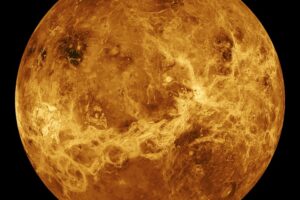One of the most striking features of Venus is its extreme temperatures. The planet’s thick atmosphere traps heat, creating a greenhouse effect that makes Venus the hottest planet in our solar system, with surface temperatures reaching up to 900 degrees Fahrenheit. This intense heat has led to the breakdown of rocks and minerals on the planet’s surface, creating a barren landscape dominated by volcanic plains and towering mountains.
But Venus is more than just a hot, inhospitable world. Recent research has revealed that the planet may have once had oceans of liquid water on its surface, as evidenced by the presence of river-like channels and possible shoreline features. This has fueled speculation that Venus may have once been a habitable world, capable of supporting life.
In addition to its past, Venus also has a fascinating present. The planet’s thick clouds are made up of sulfuric acid and other toxic compounds, creating a dazzling array of colors in the sky. These clouds also hide the planet’s surface from view, making it difficult for scientists to study Venus from afar.
To overcome these obstacles, researchers have turned to spacecraft and robotic explorers to investigate Venus up close. Missions like NASA’s Magellan and the European Space Agency’s Venus Express have provided valuable data on the planet’s geology, atmosphere, and climate. These missions have revealed a dynamic world with complex weather patterns, including intense winds and frequent lightning storms.
Looking to the future, scientists are eager to continue exploring Venus and unraveling its mysteries. Proposed missions include sending a lander to study the planet’s surface in more detail, as well as deploying drones to fly through its clouds and gather samples. These efforts could provide invaluable insights into Venus’s history, climate, and potential for future human exploration.
In conclusion, Venus remains a tantalizing world waiting to be explored. By delving deeper into its mysteries, scientists hope to not only better understand our sister planet but also shed light on the broader question of the potential for life beyond Earth. As technology advances and our knowledge grows, the secrets of Venus may soon be revealed, offering a glimpse into the wonders of our solar system and the universe beyond.






























Add Comment